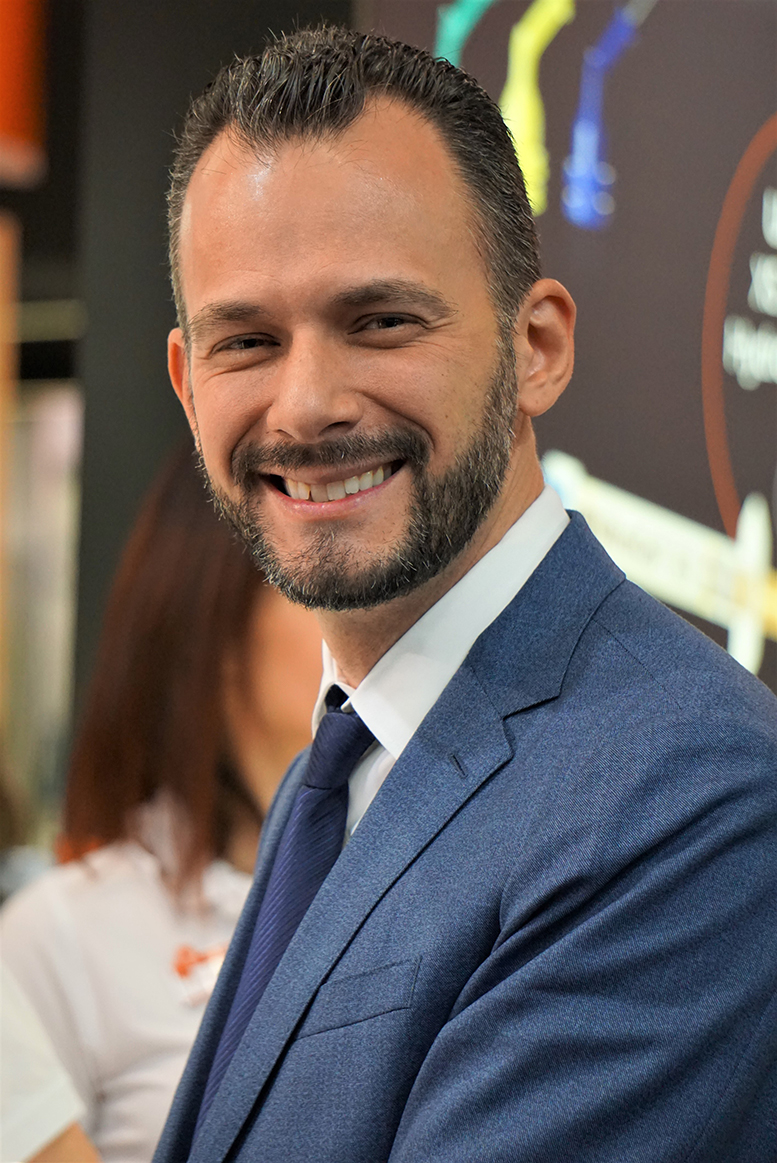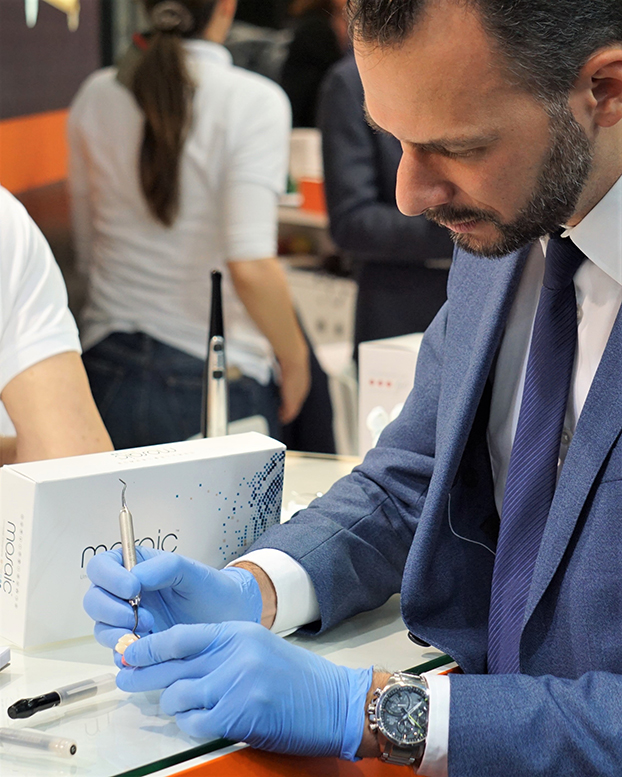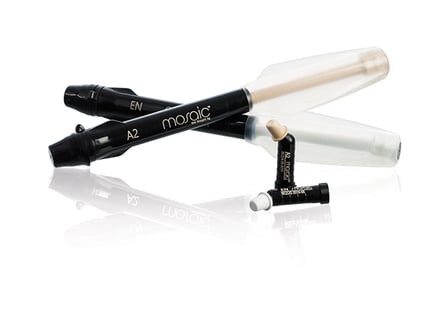During this year’s IDS in Cologne, Ultradent Products invited interested dentists to attend specific exclusive expert sessions. The sessions covered topics of special interest, clinical discussions, treatment protocols as well as tips and tricks around the latest product innovations. In a relaxed atmosphere with tasty finger foods and drinks, the guests also had the opportunity to get answers to all their professional questions and to gain hands-on experience with the corresponding products.
Dr. Rafael Beolchi, Sao Paulo/Brazil, initiated the series of expert sessions. He has almost 20 years of experience in esthetic dentistry and is well known for his international lectures and educational activities in this field. Subsequently, his expert session focused on “Esthetic Dentistry with Direct Composites: It is easier than we may think”.



Using MosaicTM Universal Composite, Dr. Beolchi explained the proven layering concept for more natural restorations: First and foremost, the opacities and translucencies follow entirely separate models.
The different opaque dentin shades, which determine the actual colour of the restoration, follow the VITA shades (A1, A2, A3).
However, the six translucent enamel colours, which are responsible for the luminosity of the restoration, do not follow the VITA shade. These can be divided in two groups with three colours each. Here, white, neutral and grey are meant to be the most important in modern esthetic dentistry. White and neutral, for example, are frequently used for whitened teeth in the dentin shade area A1 or for younger people. Older people usually have slightly darker teeth (A3-A4). Here, a more greyish enamel shade is ideally suited.
The remaining enamel shades, yellowish, transparent and reddish (enamel blush) are commonly called effect enamels. They are rather used for incisal restorations. In some cases, yellow can be used as final layer as well.
This philosophy, which Ultradent Products has followed for many years, has its roots within Prof. Lorenzo Vannini’s educational concept, known as achromatic technique, where the enamel colours do not follow the VITA shade. For instance, if an A1 dentin colour is needed in a clinical case, the enamel shades allow the user to grant subtle whitish, neutral or greyish luminosity to the tooth - depending on the patient’s age.
Mastering all aspects of luminosity is vital in the field of restorative dentistry. It is important to understand that restorations do not only rely on dentin colours and VITA shades. The key for beautiful, natural looking results is to accurately balance the opacity of the dentin and the translucency of the enamel. Neglecting this point, will lead to inadequate restorations that will remain visible to a greater or lesser extent.
For a long time, Ultradent Products has created composites according to this concept. The latest product, Mosaic Universal Composite, is no exception and is designed to cover all these requirements in an uncomplicated and convenient way. On the one hand Mosaic is characterised by its excellent handling properties - for both, anterior and posterior restorations. So far there is hardly any other composite on the market, featuring ideal spreading and sculpting properties for both indications alike.
On the other hand, it has proven long-lasting gloss retention - significantly above average. Usually, composites have to be polished from time to time. With Mosaic the gloss definitely lasts longer.
Mosaic’s shade guide is made of composite, which makes the pre-determination of the final restoration colour quick, easy and accurate. One side of the shade guide consists of the composite itself. The other side displays the composite with a layer of enamel neutral and shows ideally how translucency concept works. Mosaic is supplied in singles or syringes, which are especially designed to reduce contamination.
In summary, Dr. Beolchi made it clear that Mosaic is the material of his choice when it comes to universal usability, easy handling and reliable material properties.
Questions & Answers:
Q: Shall the composite be layered with different dentin colours?
A: Yes, that is possible and depends somewhat on the original tooth colour and the class of the restoration. In biology, things are never 100% determined and fixed. For some class III and IV restorations, I use two shades. For others, I prefer one up to three shades, in order to achieve a better result. For a class V restoration I might go for one dentin colour only.
The secret is not only to follow strict layering rules and guidelines. It is more about enjoying the work and about experimenting with the material. This way, users will gain more and more experience and will be able in time to improve their individual style of creating restorations. As already mentioned, I occasionally select three, four or even five colours for a class I restorations. In theory that is not necessary. But I personally prefer this method in some cases, as I enjoy finding the very best solution.
Q: Can a bonding agent be used to facilitate the spreading of the composite layers?
A: Spreading a composite is mandatory. Whenever different dentin colours are used in combination with enamel shades, especially enamel shades that do not follow the VITA guideline, the thickness of the layers needs to be controlled thoroughly. In my opinion, Mosaic is very well suited for this purpose as it is extremely easy to manipulate. However, to simplify a procedure, a material that moistens the composite can be used, so that the spreading becomes smoother and easier. Many dental professionals use bonding agents for this purpose. Unfortunately, this is one of the main reasons, why composites tend to fail.
Etching removes minerals from the dentin, leaving a hydroxyapatite scaffold and free collagen fibres. The collagen fibres are only useful in a moist condition. Otherwise they collapse together.
In order to properly bond to dentin, the bonding agent must contain HEMA. HEMA is a hydrophilic methacrylate. However, if a hydrophilic substance is applied on the final layer of the composite, it will bond to the composite surface and change its colour as soon as food or beverages, as for example coffee or tea, will be consumed.
The bonding agent also spreads through the moistened collagen fibres as it contains solvents. Solvents are usually based on alcohol. Spatulas and instruments are frequently cleaned with alcohol in order to dissolve the remaining composite material. Applying a bonding agent on the final layer of the composite will thus dissolve the composite and literally destroy the layer.
Therefore, I would recommend only to use products, which are especially designed to moisten the composite. They neither contain HEMA nor alcohol. A product I am fond of for example is Composite Wetting Resin. It gives users full control over the composite material and so over the thickness of the layer.
Bearing this in mind it is important to clean the instruments so they are free from bonding agent before layering the composite.
Q: Can Mosaic be used without etching or bonding?
A: No, Mosaic follows a usual treatment protocol, including all etching and bonding steps. Furthermore, there are three pillars that should be taken into consideration when it comes to direct or indirect restorations. Followed carefully, these will help to guarantee reliable and long-lasting restorations. The first one is a balanced occlusion. The second pillar is based on a well-diffused bonding procedure and the last pillar is proper light curing. Light curing does not only mean to press a button and harden a material. It means achieving a proper curing performance deep inside the composite restoration and not only on the composite surface.
Q: How often should a composite be polished?
A: Usually, a polishing procedure should be done every year or every other year. Yet, the polishing frequency depends a lot on the composite used, the curing quality and the patient’s habits regarding oral hygiene. From common experience, Mosaic provides longer gloss retention so that the polishing cycle can be extended.
Q: What might be the reasons for a class IV restoration falling apart?
A: There are mainly three reasons, which could cause a class IV restoration to fail: The first is an unbalanced occlusion with too much stress on the composite. It is important to control the movement and to ensure it is not being guided by the restoration. The second might be an inadequate bonding procedure and the third reason may originate in improper light curing. In my opinion, clinicians should thoroughly check these three factors and techniques instead of hastily blaming the composite material prematurely for failing.
Q: Does the curing power affect the composite?
A: The short answer is yes. It is vital to deliver a definite amount of energy in order to cure the composite properly. The curing time depends on the amount of light that comes out of the curing lamp. 16 joules of light have to be delivered in total.
For example, the curing process with a 1.000 mW/cm2 curing light will take 16 sec. With less power, it will obviously take longer. Also the distance between the light source and the composite, the light colour and the collimation should carefully be observed. From my experience, light curing is a very important topic, which definitely should be further studied and understood by every clinician.
Read more about Mosaic Universal Composite here.










